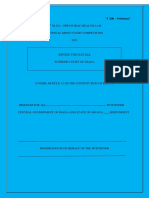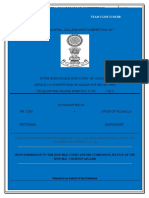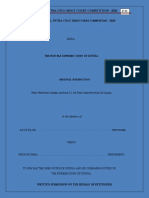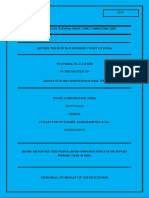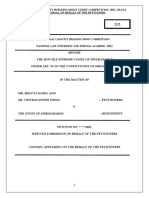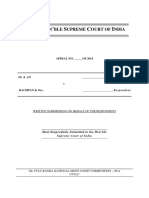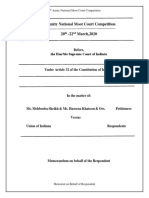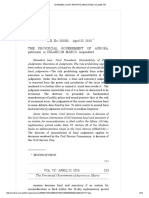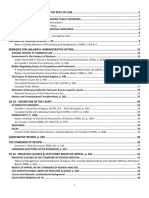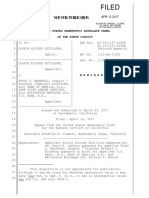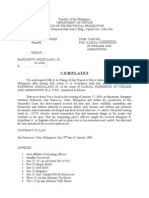SS Moot
SS Moot
Uploaded by
Rakesh RbCopyright:
Available Formats
SS Moot
SS Moot
Uploaded by
Rakesh RbOriginal Description:
Original Title
Copyright
Available Formats
Share this document
Did you find this document useful?
Is this content inappropriate?
Copyright:
Available Formats
SS Moot
SS Moot
Uploaded by
Rakesh RbCopyright:
Available Formats
TEAM CODE: 64
IN THE HONORABLE SUPREME COURT OF BHARATH NADU
Case filed seeking an Order under Article 32 of the
Constitution of Bharath Nadu
WRITTEN SUBMISSION ON BEHALF OF THE PETITIONERS
Writ Petition (Civil) No. ____of 2019
United National Congress Party Petitioner No. 1
Raith Mitra Petitioner No. 2
Bharath Nadu Youth Party Petitioner No. 3
Belliyappa Petitioner No. 4
v.
Union of Bharath Nadu Respondent No. 1
Nation Builder Respondent No. 2
Most respectfully submitted before the Hon’ble Chief Justice and companion
Judges of Supreme Court of Bharath Nadu
MEMORANDUM ON BEHALF OF THE PETITIONERS
DRAWN AND FILED BY THE COUNSELS FOR THE PETITIONERS
3rd SURANA & SURANA & KLE LAW COLLEGE CONSTITUTIONAL LAW
MOOT COURT COMPETITION, 2019. P age |I
TABLE OF CONTENTS
LIST OF ABBREVIATIONS ....................................................................................................... III
INDEX OF AUTHORITIES.......................................................................................................... V
TABLE OF CASES ...................................................................................................................... VI
STATEMENT OF JURISDICTION............................................................................................. IX
STATEMENT OF FACTS ............................................................................................................ X
STATEMENT OF ISSUES .......................................................................................................... XI
SUMMARY OF ARGUMENTS ................................................................................................. XII
ARGUMENTS ADVANCED ........................................................................................................ 1
CONTENTION 1: THAT 104TH CONSTITUTIONAL AMENDMENT VIOLATES THE PRINCIPLE OF
FEDERALISM EMBODIED UNDER THE DOCTRINE OF BASIC STRUCTURE. ...................................... 1
1.1 Meaning of the axiom “Federal” as exercised in Bharath Nadu ........................................... 2
1.1.1 Federalism as a part of basic structure ............................................................................ 2
1.2 That Art. 172(2) is an onslaught on the Constitution‟s Basic structure ................................ 3
1.2.1 Insertion of Art. 172(2) in violation of federalism ............................................................ 4
1.2.2 The Amendment is an infringement of the autonomy of the states .................................... 5
CONTENTION 2: THAT SEC. 123(9) OF THE REPRESENTATION OF PEOPLE ACT, 1951 IS
VIOLATIVE OF THE FUNDAMENTAL RIGHTS. ................................................................................. 6
2.1 That the impugned provision is superfluous. ........................................................................ 6
2.2 That it is violative of the freedom of Speech and Expression of Petitioner No. 1 ................ 7
MEMORIAL ON BEHALF OF THE PETITIONERS
3rd SURANA & SURANA & KLE LAW COLLEGE CONSTITUTIONAL LAW
MOOT COURT COMPETITION, 2019. P a g e | II
2.3 That the impugned provision is violative of Fundamental Rights of the farmers ................. 9
CONTENTION 3: THAT SEC. 29D OF THE REPRESENTATION OF PEOPLE ACT, 1951 IS VIOLATIVE
OF FUNDAMENTAL RIGHT UNDER ART. 19(1)(C). ........................................................................ 10
3.1 That the impugned law causes disturbance to the composition of the party ....................... 11
3.2 That the impugned law may have the effect on the recognition of the political party ........ 12
CONTENTION 4: THAT SEC. 168A OF THE REPRESENTATION OF PEOPLE ACT, 1951 IS
VIOLATIVE OF THE FREEDOM OF CONSCIENCE. ........................................................................... 13
4.1 That the impugned provision is violative of Art. 19 ........................................................... 13
4.2 That the impugned provision is violative of Art. 21 ........................................................... 14
PRAYER FOR RELIEF ............................................................................................................ XIII
MEMORIAL ON BEHALF OF THE PETITIONERS
3rd SURANA & SURANA & KLE LAW COLLEGE CONSTITUTIONAL LAW
MOOT COURT COMPETITION, 2019. P a g e | III
LIST OF ABBREVIATIONS
ABBREVIATION EXTENSION
& And
§ Section
¶ Paragraph
AIR All India Reporter
Anr. Another
Art. Article
Assn. Association
Co. Company
Const. Constitution
Coop. Cooperative
Cri. Criminal
ed. Edition
etc. Etcetera
Hon‟ble Honourable
i.e. that is
Ltd. Limited
MLA Member of Legislative Assembly
MP Member of Parliament
NCT National Capital Territory
MEMORIAL ON BEHALF OF THE PETITIONERS
3rd SURANA & SURANA & KLE LAW COLLEGE CONSTITUTIONAL LAW
MOOT COURT COMPETITION, 2019. P a g e | IV
No. Number
Ors. Others
PUCL People‟s Union for Civil Liberties
Pvt. Private
SC Supreme Court
SCC Supreme Court Cases
Sec. Section
U.P. Uttar Pradesh
UOI Union of India
v. Versus
Vol. Volume
MEMORIAL ON BEHALF OF THE PETITIONERS
3rd SURANA & SURANA & KLE LAW COLLEGE CONSTITUTIONAL LAW
MOOT COURT COMPETITION, 2019. P age |V
INDEX OF AUTHORITIES
STATUTES
THE CONSTITUTION OF INDIA, 1950
THE REPRESENTATION OF THE PEOPLE ACT, 1951
BOOKS AND DIGESTS
D.J. De, The Constitution of India, 2nd ed. (2005).
Durga Das Basu, Constitutional Law of India, 8th ed. (2009).
Durga Das Basu, Shorter Constitution of India, 14th ed. (2009).
H.M. Seervai, Constitutional Law of India, 4th ed. (2010).
M.P. Jain, India Constitutional Law, 7th ed. (2018).
P.K. Majumdar & R.P Kataria, Commentary on the Constitution of India, 10th ed. (2009).
V.N. Shukla‟s, Constitution of India, 11th ed. (2008).
Dr. Mrs. Kiran Jain & Mr. P.C Jain, Chawla’s Election Law and Practices, 6th ed. (1998).
Justice G.P. Singh, Principles of Statutory Interpretation, 8th ed. (2003).
DICTIONARIES, ONLINE DATABASES & WEBSITES
B.A. Garner, Black’s Law Dictionary, 8th Ed. (2004).
Supreme Court Words and Phrases, Surrendra Malik & Sumeet Malik, 3rd Ed. (2013).
www.scconline.com.
www.manupatrafast.com.
www.eci.gov.in.
MEMORIAL ON BEHALF OF THE PETITIONERS
3rd SURANA & SURANA & KLE LAW COLLEGE CONSTITUTIONAL LAW
MOOT COURT COMPETITION, 2019. P a g e | VI
TABLE OF CASES
S Name of the Case Citation Page
No. No.
1. Ashok Kumar Gupta v. State of U.P. (1997) 5 SCC 201 9
2. Ashok Kumar Thakur v. Union of India (2008) 6 SCC 1 2
3. Bhikhubhai Vithalbhai Patel & Ors. v. State of Gujarat AIR 2008 SC 1771 12
& Anr.
4. Biswanath Mallick v. State of Orrisa 1995 APLJ (Cri) 301 7
5. C. Subramaniam v. Speaker of Madras AIR 1969 Mad. 10 5
6. Commissioner for Special Purposes of Income-Tax v. (1891) AC 531 (HL) 7
John Frederick Pemsel
7. D.C. Saxena v. Chief Justice of India AIR 1996 SC 2481 13
8. Damyanti Naranga v. The Union of India AIR 1971 SC 966 10,
11
9. Dharam Dutt v. Union of India AIR 2004 SC 1295 6
10. DMDK v. Election Commission of India AIR 2012 SC 2191 10,
14
11. E.R.E. Congress v. General Manager, E. Rly. AIR 1965 Cal. 389 12
12. Francis Coralie v. Administrator, Union Territory of AIR 1981 SC 746 15
Delhi
13. Glanrock Estate Private Limited v. State of Tamil Nadu (2010) 10 SCC 96 2
14. Gokaraju Rangaraju v. State of Andhra Pradesh AIR 1981 SC 1473 7
15. Govindlal Chagganlal Patel v. Agriculture Produce AIR 1976 SC 263 10
Market Committee
16. Hamdard Dawakhana v. Union of India AIR 1960 SC 554 8
17. His Holiness Kesavananda Bharati Sripadagalvaru AIR 1973 SC 1461 1
and Ors. v. State of Kerala
18. I.R. Coelho v. State of Tamil Nadu AIR 2007 SC 861 3
MEMORIAL ON BEHALF OF THE PETITIONERS
3rd SURANA & SURANA & KLE LAW COLLEGE CONSTITUTIONAL LAW
MOOT COURT COMPETITION, 2019. P a g e | VII
19. Krishna Kumar v. State of Rajasthan AIR 1992 SC 1789 4
20. Kuldip Nayar v. Union of India AIR 2006 SC 3127 2
21. L.N. Mishra Institute of E.D. & Social Change v. State AIR 1988 SC 1136 11
of Bihar
22. Lok Prahari v. Union of India AIR 2018 SC 1041 9, 14
23. Madras Bar Association v. Union of India AIR 2015 SC 1571 4
24. Maneka Gandhi v. Union of India AIR 1978 SC 597 15
25. Minerva Mills v. Union of India AIR 1980 SC 1789 2
26. O.K. Ghosh v. E.X. Joseph AIR 1963 SC 812 12
27. Olga Tellis v. Bombay Municipal Corporation AIR 1986 SC 180 9
28. People’s Union for Civil Liberties v. Union of India AIR 2004 SC 1442 6
29. People’s Union for Civil Liberties v. Union of India AIR 2003 SC 2363 9
30. Punjab Beverages Pvt. Ltd. v. Suresh Chand AIR 1978 SC 995 3
31. Raj Krushna v. Binod Kanungo AIR 1954 SC 202 4
32. Romesh Thapar v. State of Madras AIR 1950 SC 124 8
33. S.R. Bommai v. Union of India AIR 1994 SC 1918 2, 8
34. S. Subramaniam Balaji v. Government of Tamil Nadu (2013) 9 SCC 659 8, 9
and Ors.
35. Sainik Motors, Jodhpur v. State of Rajasthan AIR 1961 SC 1480 10
36. Shri Gopal Jalan & Co. v. Calcutta Stock Exchange AIR 1964 SC 250 7
Association
37. State (NCT of Delhi) v. Union of India (2018) 8 SCC 501 5, 15
38. State of Bihar v. Yogendra Singh AIR 1982 SC 882 4
39. State of Karnataka v. Associated Management of AIR 2014 SC 2094 13
English Medium Primary & Secondary Schools
40. State of Karnataka v. Union of India AIR 1978 SC 68 7
41. State of Madras v. V.G. Row AIR 1952 SC 196 10
42. State of U.P. v. Babu Ram Upadhya AIR 1961 SC 751 10
43. State of U.P. v. Manbodhan Lal Srivastava AIR 1957 SC 912 10
MEMORIAL ON BEHALF OF THE PETITIONERS
3rd SURANA & SURANA & KLE LAW COLLEGE CONSTITUTIONAL LAW
MOOT COURT COMPETITION, 2019. P a g e | VIII
44. State of U.P. v. Renusagar Power Co. AIR 1988 SC 1737 4
45. State of West Bengal v. Committee for Protection of AIR 2010 SC 1476 2, 4
Democratic Rights
46. Sultana Begum v. Premchand Jain AIR 1997 SC 1006 4
47. Suta Ramacharya v. Senior Dy. Inspector AIR 1958 A.P. 78 14
48. U.P. Shramik Maha Sangh v. State of Uttar Pradesh AIR 1960 All. 45 12
49. Union of India v. Association for Democratic Reforms AIR 2002 SC 2112 13
50. University of Kerala v. Council of Principals of (2011) 14 SCC 357 9
Colleges
51. Unni Krishnan, JP v. State of AP AIR 1993 SC 2178 6, 7
MEMORIAL ON BEHALF OF THE PETITIONERS
3rd SURANA & SURANA & KLE LAW COLLEGE CONSTITUTIONAL LAW
MOOT COURT COMPETITION, 2019. P a g e | IX
STATEMENT OF JURISDICTION
The Petitioners i.e. United National Congress Party, Raith Mitra, Bharath Nadu Youth Party
and Belliyappa have approached the Hon’ble Supreme Court of Bharath Nadu under Art. 32
of the Constitution of Bharath Nadu.
ART. 32: REMEDIES FOR ENFORCEMENT OF RIGHTS CONFERRED BY THIS PART
1. The right to move the Supreme Court by appropriate proceedings for the enforcement of the
rights conferred by this Part is guarantee.
2. The Supreme Court shall have power to issue directions or orders or writs, including writs in
the nature of habeas corpus, mandamus, prohibition, quo warranto and certiorari, whichever
may be appropriate, for the enforcement of any of the rights conferred by this Part.
3. Without prejudice to the powers conferred on the Supreme Court by clause (1) and (2),
Parliament may by law empower any other court to exercise within the local limits of its
jurisdiction all or any of the powers exercisable by the Supreme Court under clause (2).
4. The right guaranteed by this article shall not be suspended except as otherwise provided for
by this Constitution.
MEMORIAL ON BEHALF OF THE PETITIONERS
3rd SURANA & SURANA & KLE LAW COLLEGE CONSTITUTIONAL LAW
MOOT COURT COMPETITION, 2019. P age |X
STATEMENT OF FACTS
1. Bharath Nadu is a federal country with a multiparty system and parliamentary form of
government, and is considered to have the potential of becoming a world leader.
2. However, the country is also facing certain issues like low literacy rate, farmer suicide and
political instability.
3. The Hon‟ble Supreme Court, after taking cognizance of a letter written by a prison inmate
expressing his concern about flawed electoral practices, constituted a committee to review the
Electoral Law and cull out the lacunae in it.
4. On 1st November 2018, the Supreme Court sent this report to the Union Parliament, State
Governments and all the political parties for their consideration.
5. Meanwhile the parliamentary elections were declared and Bharath Nadu Janata Party (BNJP) in
its election manifesto promised to bring in the reforms recommended by the committee.
6. The party won elections and brought an amendment to the Constitution, by way of which it
further brought some major reforms in the Electoral Law.
7. However, the newly introduced amendments were challenged on the following grounds in
separate petitions:
(a) 104th Constitutional Amendment as violative of Basic structure of the Constitution.
(b) Sec. 123(9) of the Representation of the People Act, 1951 as violative of Art. 19(1)(a).
(c) Sec. 29D of the Representation of the People Act, 1951 as violative of Art. 19(1)(c).
(d) Sec. 168A of the Representation of the People Act, 1951 as violative of Art. 19 and Art. 21.
8. Meanwhile, Nation Builder, an income taxpayers‟ association welcomed Sec. 123(9) and filed an
intervening application, and was thus arraigned as Respondent.
9. The Supreme Court admitted all the petitions and clubbed them together for a common hearing.
MEMORIAL ON BEHALF OF THE PETITIONERS
3rd SURANA & SURANA & KLE LAW COLLEGE CONSTITUTIONAL LAW
MOOT COURT COMPETITION, 2019. P a g e | XI
STATEMENT OF ISSUES
ISSUE 1
WHETHER OR NOT THE 104TH CONSTITUTIONAL AMENDMENT IS VIOLATIVE OF THE BASIC
STRUCTURE OF THE CONSTITUTION?
ISSUE 2
WHETHER OR NOT SEC. 123 (9) OF THE REPRESENTATION OF THE PEOPLE ACT, 1951 IS
VIOLATIVE OF THE FUNDAMENTAL RIGHTS?
ISSUE 3
WHETHER OR NOT SEC. 29D OF THE REPRESENTATION OF THE PEOPLE ACT, 1951 IS VIOLATIVE
OF ART. 19(1)(C)?
ISSUE 4
WHETHER OR NOT SEC. 168A OF THE REPRESENTATION OF THE PEOPLE ACT, 1951 IS
VIOLATIVE OF THE PETITIONER NO. 4‟s FREEDOM OF CONSCIENCE?
MEMORIAL ON BEHALF OF THE PETITIONERS
3rd SURANA & SURANA & KLE LAW COLLEGE CONSTITUTIONAL LAW
MOOT COURT COMPETITION, 2019. P a g e | XII
SUMMARY OF ARGUMENTS
CONTENTION 1: THAT 104TH CONSTITUTIONAL AMENDMENT VIOLATES THE PRINCIPLE OF
FEDERALISM EMBODIED UNDER THE DOCTRINE OF BASIC STRUCTURE.
It is submitted that the provision in question is in violation of Bharath Nadu‟s federal structure.
Art. 172(2) gives the Parliament arbitrary power to alter the term of the State Assemblies, which
is the prerogative of the concerned State and is mandated by the Constitution, thus violating the
principle of division of powers.
CONTENTION 2: THAT SEC. 123(9) OF THE REPRESENTATION OF THE PEOPLE ACT, 1951 IS
VIOLATIVE OF THE FUNDAMENTAL RIGHTS.
It is submitted that Sec. 123(9) is not only superfluous and unclear in objective but also violative
of various fundamental rights of the voters including their right to know under the right to
freedom of speech and expression, and economic growth and development under the right to life.
CONTENTION 3: THAT SEC. 29D OF THE REPRESENTATION OF PEOPLE ACT, 1951 IS VIOLATIVE
OF FUNDAMENTAL RIGHT UNDER ART. 19(1)(C).
It is submitted that it is the fundamental right of citizens to form assosciations and continue them
according to the will and wishes of the establishers. Thus, any kind of unwarranted interference
with the same, calls for a violation of the right to form associations.
CONTENTION 4: THAT SEC. 168A IS VIOLATIVE OF THE FREEDOM OF CONSCIENCE.
It is submitted that the Freedom of Conscience, which includes the aspect of political beliefs
including the sole decision of the person to be in a party or not, is being violated here. The right
not to be in an association is also a Fundamental right being violated in the instant case.
MEMORIAL ON BEHALF OF THE PETITIONERS
3rd SURANA & SURANA & KLE LAW COLLEGE CONSTITUTIONAL LAW
MOOT COURT COMPETITION, 2019. P age |1
ARGUMENTS ADVANCED
CONTENTION 1: THAT 104TH CONSTITUTIONAL AMENDMENT VIOLATES THE PRINCIPLE OF
FEDERALISM EMBODIED UNDER THE DOCTRINE OF BASIC STRUCTURE.
1. It is most humbly submitted before the Hon‟ble Court that Article 172(2) of the Constitution of
Bharath Nadu, introduced under the (104th Amendment) Act, 2019 is violating the principle of
federalism which forms a part of the doctrine of basic structure of the Constitution and is thus,
unconstitutional. The Hon‟ble SC in His Holiness Kesavananda Bharati Sripadagalvaru and
Ors. v. State of Kerala1 held that the Parliament‟s constituent power under Art.368 is constrained
by the inviolability of the Basic Structure of the Constitution, which is one of the Basic features
of the Constitution. The Basic Structure of the Constitution could not be destroyed or altered
beyond recognition by a constitutional amendment.
2. In the instant case, the impugned Art. gives the Parliament the power to extend or curtail the
term of any of the State Assemblies for a period it deems necessary.2 It is submitted that the
provision in question is in violation of Bharath Nadu‟s constitution and its basic structure as
Bharath Nadu is a federal country.3 Article 172(2) gives the Parliament arbitrary power to alter
the term of the State Assemblies, which is the prerogative of the concerned State and is
mandated by the Constitution,4 thus violating the principle of division of powers. Any expansion
of Art.368 to achieve consequence of total repeal has been held to be violative of the basic
structure.5
1
His Holiness Kesavananda Bharati Sripadagalvaru and Ors. v. State of Kerala, AIR 1973 SC 1461.
2
Moot Proposition, ¶ 7.
3
Moot Proposition, ¶ 1.
4
India Const. art. 172(1).
5
Bar Council of India Trust, Amendment of the Constitution in Constitutional Law of India.
MEMORIAL ON BEHALF OF THE PETITIONERS
3rd SURANA & SURANA & KLE LAW COLLEGE CONSTITUTIONAL LAW
MOOT COURT COMPETITION, 2019. P age |2
1.1 Meaning of the axiom “Federal” as exercised in Bharath Nadu
3. It is submitted that the Bharath Nadu is a federal state and this principle has also been enshrined
under the doctrine of basic structure. In S.R. Bommai v. Union of India,6 this Court held that the
principle of federalism has not been watered down so as to make the Constitution unitary in
character. Under the Constitution there is a three-fold distribution of legislative powers between
the Union and the States and for that Seventh Schedule to the Constitution divides the subjects of
the legislation under the three lists viz. List I (Union List), List II (State List) and List III
(Concurrent List).7 Moreover, neither the relative importance of the legislative entries in
Schedule VII List I over List II of the Constitution nor the fiscal control by the union per se is
decisive to conclude that the Constitution is unitary. 8
1.1.1 Federalism as a part of basic structure
4. The power to amend the Constitution is a derivative power. The exercise of such power to amend
the Constitution is subject to two limitations, namely, the doctrine of basic structure and lack of
legislative competence. The basic structure doctrine provides a touchstone on which the validity
of a Constitutional amendment under Art.368 could be judged.9
5. The basic structure of the Constitution is to be taken as a larger principle on which the
Constitution itself is framed and some of the illustrations given as to what constitutes the basic
structure of the Constitution would show that they are not confined to the alteration or
modification of any of the fundamental rights alone or any of the provisions of the
Constitution.10 The federal principle is said to be the basis of the Constitution.11 Since the power
6
S.R. Bommai v. Union of India AIR 1994 SC 1918.
7
State of West Bengal v. Committee for Protection of Democratic Rights, AIR 2010 SC 1476.
8
Kuldip Nayar v. Union of India, AIR 2006 SC 3127.
9
Glanrock Estate Private Limited v. State of Tamil Nadu, (2010) 10 SCC 96.
10
Ashok Kumar Thakur v. Union of India, (2008) 6 SCC 1.
11
Minerva Mills v Union of India, AIR 1980 SC 1789.
MEMORIAL ON BEHALF OF THE PETITIONERS
3rd SURANA & SURANA & KLE LAW COLLEGE CONSTITUTIONAL LAW
MOOT COURT COMPETITION, 2019. P age |3
to amend the Constitution is unlimited, if changes brought about by amendments destroy the
identity of the Constitution, such amendments would be void.12
6. In the present case in order to introduce the synchronization of elections, the Constitution (104th
Amendment) Act, 2019, was passed as a prerequisite. However, it is humbly contended that the
amendment rather than introducing a constitutionally valid method to conduct elections which it
aimed at doing, has come out to be a deceptively non-federal insertion of provisions infringing
state autonomy. It is a settled law that within the sphere allotted to the states they are supreme
and the Centre cannot tamper with their powers.13 Hence, the basic structure of the Constitution
is being whittled down, making the impugned legislative action unconstitutional.
1.2 That Art. 172(2) is an onslaught on the Constitution’s Basic structure
7. It is submitted that even though the reform was introduced to address the concern of unjustified
burden on the exchequer due to multiple unsynchronized elections, the amendment rather than
dividing powers between the Centre and the States, empowers the Centre with all powers, while
the States are arbitrarily suppressed. One possible source from which the Parliament seems to
have derived this power is Entry 72, List I, Schedule 7 of the Constitution. However, the Centre
has failed to give due consideration to the ambit of powers as provided for by the said Entry
while also failing to acknowledge an essential constitutional mandate as embodied under Art.
172(1) of the Constitution.
8. It is a settled rule of interpretation that one provision of the Act should be construed with
reference to other provisions in the same Act so as to make a consistent enactment of the whole
statute.14 It is the duty of the courts to avoid “a head on clash”15 between two sections of the
12
I.R. Coelho v. State of Tamil Nadu, AIR 2007 SC 861.
13
Bar Council in India Trust Supra. Note 5.
14
Punjab Beverages Pvt. Ltd. v. Suresh Chand, AIR 1978 SC 995.
MEMORIAL ON BEHALF OF THE PETITIONERS
3rd SURANA & SURANA & KLE LAW COLLEGE CONSTITUTIONAL LAW
MOOT COURT COMPETITION, 2019. P age |4
same Act and, “whenever it is possible to do so, to construe provisions which appear to conflict
so that they harmonise”.16 A familiar approach in all such cases is to find out which of the two
apparently conflicting provisions is more general and which is more specific and to construe the
more general one as to exclude the more specific.17 If a special provision is made on a certain
matter that matter is excluded from the general provision.18
9. Moreover, it has been authoritatively held that an amendment to the provisions of Constitution
would not be sustainable if it violated the basic structure of the Constitution, even though the
amendment had been carried out by the procedure contemplated under the Constitution.19
1.2.1 Insertion of Art. 172(2) in violation of federalism
10. The amendment inserted in the Constitution empowers the Parliament to extend or curtail the
term of any state assembly for a period „it deems necessary‟ for the purpose of synchronizing the
elections. This is a direct interference of the Centre in the affairs of the State. Though,
undoubtedly, the Constitution exhibits supremacy of Parliament over State Legislatures, yet the
principle of federal supremacy laid down in Article 246 of the Constitution cannot be resorted to
unless there is an irreconcilable direct conflict between the entries in the Union and the State
List.20
11. In order to hold simultaneous national and state elections, all state Assembly polls have to be
brought in sync from their present temporal offsets. Thus, certain state assemblies will have to be
elected way before their normal term ends while others will last longer than their mandated term
of five years. That in itself is unfair to the sovereign democratic mandate given to states in the
15
Raj Krushna v. Binod Kanungo, AIR 1954 SC 202; Sultana Begum v. Premchand Jain, AIR 1997 SC 1006.
16
Krishna Kumar v. State of Rajasthan, AIR 1992 SC 1789.
17
State of U.P. v. Renusagar Power Co., AIR 1988 SC 1737.
18
State of Bihar v. Yogendra Singh, AIR 1982 SC 882.
19
Madras Bar Association v. Union of India, AIR 2015 SC 1571.
20
State of West Bengal v. Committee for Protection of Democratic Rights, West Bengal, AIR 2010 SC 1476.
MEMORIAL ON BEHALF OF THE PETITIONERS
3rd SURANA & SURANA & KLE LAW COLLEGE CONSTITUTIONAL LAW
MOOT COURT COMPETITION, 2019. P age |5
first place, and all this for reasons of cost-cutting and vaguely expressed sentiments about
governance efficiency and stability seems to be constitutionally unfounded.
12. The idea of federalism is that of cooperation, however, there is an element of dictatorship in the
instant case as there is a virtual veto exercised by the Union at the Centre.
1.2.2 The Amendment is an infringement of the autonomy of the states
13. The Union and the states both derive their authority from the Constitution which divides all
powers- legislative, executive and financial, between them. The result is that the states are not
delegates of the Union and that, though there are agencies and devices of Union control over the
states in many matters- subject to such exceptions, the states are autonomous within their own
spheres as allotted by the constitution.21
14. It is humbly submitted that the powers, privileges and immunities secured for the State
Legislature under Art. 194(3) do not form a law at all, in the juristic sense; actually this corpus is
part of the law of the Constitution itself. More so, nor can it be contended that such law is
amorphous or unascertainable; though it may be true that certain sources of the law, comprising
precedents are not easily available.22 In the instant case it has been clearly mentioned that the
power to extend or curtail the term of the state assemblies will be at the discretion of the
Parliament. The essence of federal polity is that there is no uncalled for interference by the
Centre in the matter of the States which leads to the encroachment of its rights. 23 Since the states
are not being given the freedom to decide the functioning of the State assemblies, they are
serving as mere puppets at the hands of the Centre and is thus not adhering to the basic structure
principal of federalism and should be held unconstitutional.
21
D.D.Basu, Introduction to the Constitution of India, (21st ed. 2014).
22
C. Subramaniam v. Speaker of Madras, AIR 1969 Mad 10 (FB)
23
State (NCT of Delhi) v. Union of India, (2018) 8 SCC.
MEMORIAL ON BEHALF OF THE PETITIONERS
3rd SURANA & SURANA & KLE LAW COLLEGE CONSTITUTIONAL LAW
MOOT COURT COMPETITION, 2019. P age |6
CONTENTION 2: THAT SEC. 123(9) OF THE REPRESENTATION OF PEOPLE ACT, 1951 IS
VIOLATIVE OF THE FUNDAMENTAL RIGHTS.
15. It is humbly submitted before the Hon‟ble Court that Sec. 123(9) of the Representation of the
People Act, 1951 which mandates the declaration of making enticing promises, giving freebies,
loan waivers, etc. in election manifestos as a corrupt practice, is violative of various fundamental
rights, thus bringing its validity into question. The courts have time and again held that out of the
several rights enumerated in clause (1) of Article 19, the right of sub-clause (a) is not merely a
right of speech and expression but right to freedom of speech and expression. The enumeration
of other rights is not by reference to freedom.24 These rights have been advisedly set out in broad
terms leaving scope for their expression and adaptation, through interpretation, to the changing
needs and evolving notions of a free society.25
16. Moreover, according to the Supreme Court of India‟s doctrine of implied Fundamental Rights,
the court asserted that in order to treat a right as a Fundamental Right, it is not obligatory that it
must be expressly stated in the constitution as a Fundamental Right. Political, social and
economic changes occurring in the country may lead to recognition of new rights and the law in
its eternal youth grows to meet its social demands.26
2.1 That the impugned provision is superfluous.
17. It is humbly submitted that the impugned provision has imposed restrictions on the political
parties from putting forth their promises in election manifesto, if made „solely with a view to
24
Dharam Dutt v. Union of India, AIR 2004 SC 1295.
25
People‟s Union for Civil Liberties v. Union of India, AIR 2004 SC 1442.
26
Unni Krishnan, JP v. State of AP, AIR 1993 SC 2178.
MEMORIAL ON BEHALF OF THE PETITIONERS
3rd SURANA & SURANA & KLE LAW COLLEGE CONSTITUTIONAL LAW
MOOT COURT COMPETITION, 2019. P age |7
secure votes‟27 However, what the Respondent No. 1 has failed to understand is that the
expression itself is superfluous and non-implementable for the reason of subjectivity.28
18. It has been concluded by the Hon‟ble Apex Court time and again that such provisions are often
introduced ex majore cautela to quiet the fears of those whose interests are engaged or
sympathies aroused in favour of some particular institution.29 It is not uncommon to find the
Legislature inserting superfluous provision under the influence of what may be abundant
caution.30 Such superfluous provisions cannot lay the foundation for an argument resting on the
maxim, „expressio unius est exclusio alterious‟ and the maxim31 is inapplicable in such cases.
When a provision in the Act owes its origin to a confusion of ideas or to abundant caution, the
court reaches the conclusion that the provision is superfluous,32 and should therefore be quashed.
2.2 That it is violative of the freedom of Speech and Expression of Petitioner No. 1
19. It is humbly submitted that freedom of Speech and Expression occupies first place in the list of
liberties guaranteed under Art. 19(1)(a) of the Constitution and is the stockade of the democratic
process. It has been said that freedom of speech and expression is the mother of all other
liberties.33 Freedom of speech plays an imperative role in the formation of public opinion on
social, political and economic matters.34 However, the impugned section lays down a
preposterous and arbitrary censor on what a political party can and cannot include in their
manifestoes, and thus is in absolute violation of Article 19(1)(a).
27
Moot Proposition, ¶ 8.
28
Biswanath Mallick v. State of Orrisa, 1995 APLJ (Cri) 301.
29
Commissioner for Special Purposes of Income-Tax v. John Frederick Pemsel, (1891) AC 531 (HL).
30
Gokaraju Rangaraju v. State of Andhra Pradesh, AIR 1981 SC 1473.
31
State of Karnataka v. Union of India, AIR 1978 SC 68.
32
Shri Gopal Jalan & Co. v. Calcutta Stock Exchange Association, AIR 1964 SC 250.
33
India Second Press Commission, Report of the Second Press Commission of India (Controller of Publications,
Vol. I, 1982) 34-35.
34
Unni Krishnan, JP v. State of AP, AIR 1993 SC 2178.
MEMORIAL ON BEHALF OF THE PETITIONERS
3rd SURANA & SURANA & KLE LAW COLLEGE CONSTITUTIONAL LAW
MOOT COURT COMPETITION, 2019. P age |8
20. It needs to be understood that the manifesto of a political party is a statement of its policy. It is
the promise of a future government.35 It is a written statement declaring the issuer‟s principles,
policies or intention,36 and therefore clearly falls under their freedom of speech and expression.
Here, “expression” includes the freedom of propagation of ideas, their publication and
circulation,37 along with the right to acquire and import ideas and information about matters of
common interest.38 The ambit of freedom of expression further extends to the ability to express
one‟s thoughts without government restrictions.39 This freedom becomes even more necessary
in a democratic setup where the political parties need to be given an opportunity to put forth their
policies to the public so as to be able to effectively exercise their electoral rights.40
21. Moreover, it is further submitted that the apex court in S.R Bommai and Ors. v. Union of India
and Ors.41, laid down an exhaustive list of restrictions on an election manifesto by clearly
holding that the manifesto of a political party should be consistent with these fundamental and
basic features of the constitution; secularism, socio-economic and political justice, fraternity,
unity and national integrity. Thus, to put any kind of restriction on the election manifestos
beyond the grounds laid down by the Hon‟ble Supreme Court just goes on to prove its arbitrary
nature and its clear contradiction to the functioning of the fundamental freedom laid down under
Art. 19(1)(a). Therefore, it is humbly submitted that to let such a legislation stand, would be to
allow the Parliament to violate the supremacy of the country‟s grundnorm.
35
S.Subramaniam Balaji v. Government of Tamil Nadu and Ors., (2013) 9 SCC 659.
36
Manifesto, Black‟s Law Dictionary, (8th ed. 2004).
37
Romesh Thapar v. State of Madras, AIR 1950 SC 124.
38
Hamdard Dawakhana v. Union of India, (1960) 2 SCR 671.
39
Freedom of Expression, Black‟s Law Dictionary, (8th ed. 2004).
40
India The Representation of the People Act § 79(d) (1951).
41
S.R Bommai and Ors. v. Union of India and Ors. AIR 1994 SC 1918.
MEMORIAL ON BEHALF OF THE PETITIONERS
3rd SURANA & SURANA & KLE LAW COLLEGE CONSTITUTIONAL LAW
MOOT COURT COMPETITION, 2019. P age |9
2.3 That the impugned provision is violative of Fundamental Rights of the farmers
22. It is submitted that the impugned provision is in violation of the farmers‟ fundamental Right to
know, covered under the Right to Freedom of Speech and Expression.42 Every voter, whether a
farmer or not, has the fundamental right to make an informed choice43 before voting for a
particular party.44 However, in the instant case, the provision in question, prohibits the parties
from putting forth their intention of making positive changes or bringing about welfare schemes
for people, in case they come to power,45 thus making people exercise their right to vote without
having full knowledge of the possible capabilities of the party. This completely defeats their
right to make informed choices.
23. It is further submitted that Sec. 123(9) has the potential of paving way for the violation of the
Right to Life and thus Livelihood of farmers which is a fundamental right covered under the
ambit of the Right to Life and Personal Liberty.46 It is essential to take into consideration that the
right to livelihood is no more confined to the bare physical survival. Even the distribution of
freebies to the needy has been justified to fall under the ambit of basic requirements of
livelihood,47 and therefore an incidental duty is cast upon a welfare state to fulfil the same in
accordance with the Directive Principles of State Policy.48
24. It is also submitted that the right to life envisages the right to social justice and economic
empowerment as well.49 However, the impugned law by curtailing the declaration of policies by
the parties, clearly lowers down the standards of accountability and sense of security, and hence
is violative of right to life and personal liberty.
42
Lok Prahari v. Union of Inida, AIR 2018 SC 1041.
43
University of Kerala v. Council of Principals of Colleges, (2011) 14 SCC 357.
44
People‟s Union for Civil Liberties v. Union of India, AIR 2003 SC 2363.
45
Moot Proposition, ¶ 7.
46
Olga Tellis v. Bombay Municipal Corporation, AIR 1986 SC 180.
47
Subramaniam Balaji v. Government of Tamil Nadu and Others, (2013) 9 SCC 659.
48
India Const. art. 38.
49
Ashok Kumar Gupta v. State of U.P., (1997) 5 SCC 201.
MEMORIAL ON BEHALF OF THE PETITIONERS
3rd SURANA & SURANA & KLE LAW COLLEGE CONSTITUTIONAL LAW
MOOT COURT COMPETITION, 2019. P a g e | 10
CONTENTION 3: THAT SEC. 29D OF THE REPRESENTATION OF PEOPLE ACT, 1951 IS VIOLATIVE
OF FUNDAMENTAL RIGHT UNDER ART. 19(1)(C).
25. It is humbly submitted that Art. 19(1)(c) guarantees to the citizens of India the right to form
associations or unions or co-operative societies. A political party is an association of individuals
pursuing certain shared beliefs. The right to form associations is the very lifeblood of democracy.
Without such a right, political parties cannot be formed and without such parties a democratic
form of government, especially that of the parliamentary type, cannot be run properly.50
26. The Hon‟ble Supreme Court in State of Madras v. V.G. Row,51 emphasised that curtailing the
right to form associations was fraught with serious potential reactions in political fields. In the
present matter, Sec. 29D of the Representation of the People Act, 1951 must be held to be
unconstitutional for violating the mandate under Art. 19(1)(c), because the provision vests
subjective discretion in the hands of the Election Commission by way of Sec. 29E, and leaves no
scope for justifiability on the factual grounds. “The right to form an association” “necessarily
implies that the persons forming the association, have also the right to continue to be associated
with only those whom they voluntarily admit in the association. Any law by which members are
introduced in the voluntary association contrary to the manner in which the founding members
intended it to be, it will be a law violating the right to form an association.”52 Moreover, the
provisions as laid down under Sec. 29D and Sec. 29E are mandatory in nature since the use of
the word „shall‟ raises a prima facie presumption that the particular provision is imperative.53
50
DMDK v. Election Commission of India, AIR 2012 SC 2191.
51
State of Madras v. V.G. Row AIR 1952 SC 196.
52
Damyanti Naranga v. The Union of India, AIR 1971 SC 966.
53
State of U.P. v. Manbodhan Lal Srivastava, AIR 1957 SC 912; State of U.P. v. Babu Ram Upadhya, AIR 1961 SC
751; Sainik Motors, Jodhpur v. State of Rajasthan, AIR 1961 SC 1480; Govindlal Chagganlal Patel v. Agriculture
Produce Market Committee, AIR 1976 SC 263.
MEMORIAL ON BEHALF OF THE PETITIONERS
3rd SURANA & SURANA & KLE LAW COLLEGE CONSTITUTIONAL LAW
MOOT COURT COMPETITION, 2019. P a g e | 11
3.1 That the impugned law causes disturbance to the composition of the party
27. It is humbly submitted that the Hon‟ble SC in S.P. Mittal v. Union of India54 clearly observed
that any tampering with the governing body of an association may be said to be the violation of
their right to freedom of association. This clearly implies that the term „composition‟ within its
ambit does not only include the number of persons in an association but also the manner in
which they are to be placed within the association.
28. It is further submitted that any law compulsorily altering the composition of the association
amounts to a breach of the right to form the association because it violates the composite right of
forming an association and the right to continue it as the original members desired it. The right
under Art. 19(1)(c) also protects the right to continue the association with its own composition as
voluntarily agreed upon by the persons forming the association.
29. Furthermore, if the freedom to choose their representative in the manner the association wants to
do it is not vested in the association itself, the right under Art. 19(1)(c) would be meaningless.
The right can be effective only if it is held to include within it the right to continue the
association with its composition as voluntarily agreed upon by the persons forming the
association. If there is any interference with the society, its constitution or composition, the
Fundamental Right to form an association may be said to be infringed. 55 Similarly, the impugned
law does not merely regulate the affairs of the political party; it also alters its composition. Any
law altering the composition of association compulsorily has been held to be a breach of the right
to form the association of the original members guaranteed under Art. 19(1)(c) and such a law
cannot be protected under Art. 19(4).56
54
S.P. Mittal v. Union of India (1983) 1 SCC 51.
55
L.N. Mishra Institute of E.D. & Social Change v. State of Bihar, AIR 1988 SC 1136.
56
Damyanti Naranga v. The Union of India, AIR 1971 SC 966.
MEMORIAL ON BEHALF OF THE PETITIONERS
3rd SURANA & SURANA & KLE LAW COLLEGE CONSTITUTIONAL LAW
MOOT COURT COMPETITION, 2019. P a g e | 12
3.2 That the impugned law may have the effect on the recognition of the political party
30. It is humbly submitted that Sec. 29A of the Representation of the People Act, 1951 gives powers
to the Election Commission to register or not to register a political party57 after looking into
several requirements as laid under Sec.29A(5). Through the impugned law, the Parliament has
now made it mandatory to practice the method of elections for the leadership position, and has
indirectly vested discretion in the hands of the election commission to grant the registration to
any political party. It has further been observed that recognition or non-recognition of an
association by the government may affect the right to form an association.58 Recognising the
importance of the right of forming associations in a democratic society, the Courts have not
favoured the vesting of absolute discretion in the executive to interfere with the Fundamental
Right.59
31. In the present matter, formation and pursuance of a political party becomes vitally linked up with
government recognition, for without recognition the right to form association becomes illusory.
In such a situation, Art. 19(1)(c) would control the power of the government to recognise the
associations. These conditions for recognition are held to contravene Art. 19(1)(c).60
32. Therefore, it is humbly submitted that the rule in question is neither reasonable nor in the interest
of “public order” under Art. 19(4). The restriction is such as to make the right guaranteed under
Art. 19(1)(c) illusory since the election commission can refuse recognition of a political party on
considerations which might not have any direct or reasonable connection with discipline or
efficiency of the political party or the public order.61
57
India The Representation of the People Act, Sec. 29A(7) (1951).
58
U.P. Shramik Maha Sangh v. State of Uttar Pradesh, AIR 1960 All. 45
59
Bhikhubhai Vithalbhai Patel & Ors. v. State of Gujarat & Anr., AIR 2008 SC 1771.
60
E.R.E. Congress v. General Manager, E. Rly., AIR 1965 Cal. 389.
61
O.K. Ghosh v. E.X. Joseph, AIR 1963 SC 812.
MEMORIAL ON BEHALF OF THE PETITIONERS
3rd SURANA & SURANA & KLE LAW COLLEGE CONSTITUTIONAL LAW
MOOT COURT COMPETITION, 2019. P a g e | 13
CONTENTION 4: THAT SEC. 168A OF THE REPRESENTATION OF PEOPLE ACT, 1951 IS
VIOLATIVE OF THE FREEDOM OF CONSCIENCE.
33. It is humbly submitted before the Hon‟ble Court that Sec. 168A of the Representation of the
People Act, 1951, is in blatant violation of the Right to Freedom of Conscience. The said right
has a wide ambit and is directly in relation to the person‟s right to choose according to his
conscience.62 In practical terms the freedom of conscience implies a right to hold or entertain
freely any faith or belief in accordance with one‟s own prudence and consciousness.63 With the
same spirit these concepts have been incorporated in the Constitution and are well reflected by
many of its provisions inter alia Art. 19, 21 and 25.64
4.1 That the impugned provision is violative of Art. 19
34. It is humbly submitted that the Freedom of Expression has been held to be vital to the
maintenance of a free society and essential to the rule of law and liberty of the citizens. 65 The
Right to freedom of expression as enshrined in Article 19(1)(a) is not and ought not to be
confined to expressing something orally in words or in writing.66 Even a manifestation of an
emotion, feeling, etc. without words would amount to expression.67
35. However, in the instant case, the impugned provision, by imposing a sanction on the person‟s
right to choose the political party that he wants to be affiliated with, while evidently being
qualified to hold the concerned office, overtly violates the right to choose of the person.
Moreover, his right to freedom of conscience which may further fall under the ambit of the Right
62
David Feldman Civil Liberties & Human Rights (2nd ed. 2000).
63
K.S Puttaswamy v. Union of India (2017) 10 SCC 1.
64
Id.
65
D.C. Saxena v. Chief Justice of India, AIR 1996 SC 2481.
66
Union of India v. Association for Democratic Reforms, AIR 2002 SC 2112.
67
State of Karnataka v. Associated Management of English Medium Primary & Secondary Schools, AIR 2014 SC
2094.
MEMORIAL ON BEHALF OF THE PETITIONERS
3rd SURANA & SURANA & KLE LAW COLLEGE CONSTITUTIONAL LAW
MOOT COURT COMPETITION, 2019. P a g e | 14
to Freedom of Speech and Expression and the Right not to be a part of an association as granted
under Art. 19(1)(a) and Art. 19(1)(c) respectively.
36. A fair analogy can be drawn by considering the right to choose of voters, which flows from their
right to know,68 covered under Article 19(1)(a) which enables them to vote for the political party
they wish to vote for, after forming an opinion according to their conscience and best of justice.
In the same regard, it was held that nothing is more important for sustenance of democratic
polity than the voter making an intelligent and rational choice of his or her representative. 69 It is
submitted that if it is the fair right of voters to vote for the party whose beliefs they support then
it is essential that MPs and MLAs also have the right to be in the party whose beliefs they
support and making this choice an intelligent and rational one as well as they are ultimately
representing the people and not the party.
37. All the citizens have a fundamental right to associate for the advancement of political beliefs and
opinions held by them and can either form or join a political party of their choice. 70 It is thus
submitted that the said provision is also violative of Article 19(1)(c) on the ground that right to
freedom to form associations includes within its ambit the right not to be a member of an
association.71 In the instant case, a simple resignation will lead to the member being charged
with exemplary costs, thus violating his right to withdraw the membership of the association.
4.2 That the impugned provision is violative of Art. 21
38. It is humbly submitted that Sec. 168A infringes the right enshrined under Art. 21 of the
Constitution. Art. 21 extends the scope of “personal liberty” to include the right to carry on
68
Lok Prahari v. Union of Inida, AIR 2018 SC 1041.
69
PUCL v. Union of India, (2003) 4 SCC 399.
70
DMDK v. Election Commission of India, AIR 2012 SC 2191.
71
Suta Ramacharya v. Senior Dy. Inspector, AIR 1958 A.P. 78.
MEMORIAL ON BEHALF OF THE PETITIONERS
3rd SURANA & SURANA & KLE LAW COLLEGE CONSTITUTIONAL LAW
MOOT COURT COMPETITION, 2019. P a g e | 15
functions and activities as (they) constitute the bare minimum expression of human self.72 This
itself lays emphasis on giving all people the basic freedoms to express themselves, including the
right to be associated as well as the right to form different beliefs. In the light of the above, an
overlapping of distinct fundamental rights has been established to protect certain freedoms under
multiple fundamental rights, thus stressing the importance of the said fundamental freedoms.73
39. The Hon‟ble SC in K.S Puttaswamy v. Union of India74 while interpreting the ambit of Freedom
of Conscience held that there are areas other than religious beliefs which form part of the
individual‟s freedom of conscience such as political belief etc. which form part of the liberty
under Art. 21. Therefore, a man‟s political beliefs, which further goes on to be a part of his
conscience, have been included under the ambit of Art. 21.
40. In the present case, Petitioner No. 4 as per the reasonable exercise of his fundamental freedoms
has the right to shift his political affiliations in light of his political beliefs, and any other
contravening policy will not only be unconstitutional but also extremely harmful and suffocating
for public.75 However, the Parliament by way of impugned law has tried to restrict this
fundamental freedom without any reasonable ground.
41. Moreover, as an elected representative the Petitioner‟s accountability lays not only with the
political party, but also with the supreme authority of the land, that is, the People.76 Therefore,
the Petitioner No. 4 should not be arbitrarily curbed while exercising his fundamental freedoms
reasonably, and in line with his accountability to the people while also holding-up the basic
principles as laid down in the Constitution.77
72
Francis Coralie v. Administrator, Union Territory of Delhi, AIR 1981 SC 746.
73
Maneka Gandhi v Union of India, AIR 1978 SC 597.
74
K.S Puttaswamy v. Union of India (2017) 10 SCC 1.
75
Mittal, S.P. v. Union of India (1983) 1 SCC 51.
76
State (NCT of Delhi) v. Union of India, (2018) 8 SCC 501.
77
Subramanian Swamy v. Union of India (2016) 7 SCC 221.
MEMORIAL ON BEHALF OF THE PETITIONERS
3rd SURANA & SURANA & KLE LAW COLLEGE CONSTITUTIONAL LAW
MOOT COURT COMPETITION, 2019. P a g e | XIII
PRAYER FOR RELIEF
In light of the facts of the case, issues raised, arguments advanced and authorities cited, the
Counsels on behalf of the Petitioners humbly pray before the Hon‟ble Supreme Court of Bharath
Nadu to kindly adjudge and declare that:-
a) Art. 172(2) is violative of the Basic Structure of the Constitution of Bharath Nadu and
therefore shall be struck down.
b) Sec. 29D, Sec. 29E, Sec. 123(9) and Sec. 168A of the Representation of the People Act,
1951 are violative of the Fundamental Rights of the Petitioners and therefore shall be
struck down.
AND/OR
Pass any other order which the bench deems fit in the best interest of Justice, Equity and Good
Conscience, and for this act of kindness the Counsels on behalf of the Petitioners as in duty
bound shall forever pray.
All of which is respectfully submitted
__________________________
Sd/-
Counsels for Petitioners
MEMORIAL ON BEHALF OF THE PETITIONERS
You might also like
- Am Jur False ImprisonmentDocument259 pagesAm Jur False ImprisonmentScott Odam100% (4)
- Essential Soft Skills for Lawyers: What They Are and How to Develop ThemFrom EverandEssential Soft Skills for Lawyers: What They Are and How to Develop ThemNo ratings yet
- On - Behalf - of - Petitioner - T 208Document20 pagesOn - Behalf - of - Petitioner - T 208Maahi SangwanNo ratings yet
- NMCC 2020 22RDocument29 pagesNMCC 2020 22RKrishna Singh100% (1)
- Moot Problem RAM Moot Court Competition 2016Document12 pagesMoot Problem RAM Moot Court Competition 2016Vidushi TrehanNo ratings yet
- Heirs of Crisologo V RanonDocument2 pagesHeirs of Crisologo V RanonPraisah Marjorey Picot100% (2)
- Revised Penal Code (Art 1 - 20)Document11 pagesRevised Penal Code (Art 1 - 20)Jeremiah ReynaldoNo ratings yet
- Surana & Surana & KLE (P) - 64Document33 pagesSurana & Surana & KLE (P) - 64Adarsh TripathiNo ratings yet
- X A L M C C: Team Code: Als-02Document27 pagesX A L M C C: Team Code: Als-02lokesh sai100% (1)
- Final Petitioner Memo DYPatil PDFDocument32 pagesFinal Petitioner Memo DYPatil PDFKetanSrivastava'mukul'100% (1)
- Public Interest Litigation No. /2021 - Sanjeev Kumar SinghDocument44 pagesPublic Interest Litigation No. /2021 - Sanjeev Kumar SinghSanjeev SinghNo ratings yet
- MMC 10 RDocument25 pagesMMC 10 Raman100% (1)
- Petitioner PDFDocument30 pagesPetitioner PDFanon_517814950No ratings yet
- Memorial For Petitioner, CLSGIBS06 PDFDocument35 pagesMemorial For Petitioner, CLSGIBS06 PDFRakshit Taneja100% (1)
- 3rd Surana Surana and KLE Law College Constitutional Law Moot 2019 Case 1Document3 pages3rd Surana Surana and KLE Law College Constitutional Law Moot 2019 Case 1Maaz AlamNo ratings yet
- 6 PDocument36 pages6 PRazor RockNo ratings yet
- Memorial On Constitutional LawDocument23 pagesMemorial On Constitutional LawSejal PatidarNo ratings yet
- Memo Petitioner FullDocument42 pagesMemo Petitioner Fullsindhuja KNo ratings yet
- Before The Hon'Ble Supreme Court of SindhianaDocument20 pagesBefore The Hon'Ble Supreme Court of SindhianadarshiniNo ratings yet
- GENERAL INTRA CNLU MOOT COURT COMPETITION, Memo Jai HoDocument29 pagesGENERAL INTRA CNLU MOOT COURT COMPETITION, Memo Jai HoDivya RounakNo ratings yet
- A 48Document36 pagesA 48VASUDEVA KASHYAPNo ratings yet
- Petitioner MemorialDocument38 pagesPetitioner MemorialsanavibolyNo ratings yet
- Memorial Submission 10th Semester FinalDocument19 pagesMemorial Submission 10th Semester Final17093 SUBIYAH HAFEEZ SIDDIQUINo ratings yet
- Second Internal Moot Court Balaji Law College, Pune: VersusDocument27 pagesSecond Internal Moot Court Balaji Law College, Pune: VersusDiksha MundhraNo ratings yet
- Pranjal Petitioner DraftDocument30 pagesPranjal Petitioner DraftpranjalNo ratings yet
- M-Memo Defendant FinalDocument26 pagesM-Memo Defendant FinalRishabh60% (10)
- UntitledDocument40 pagesUntitleddivyaNo ratings yet
- Moot Preposition On Constitutional LawDocument12 pagesMoot Preposition On Constitutional LawSejal PatidarNo ratings yet
- T-18 Respondant MemorialDocument27 pagesT-18 Respondant MemorialAgarwal SaranshNo ratings yet
- Rostrum Legal Winning MemorialDocument35 pagesRostrum Legal Winning MemorialDinesh Kumar SamantaNo ratings yet
- 07P (Petitioner) - CMR Moot 2020Document27 pages07P (Petitioner) - CMR Moot 2020MuheebNo ratings yet
- 31PDocument28 pages31PSathvik AmarnathNo ratings yet
- Amity Respondent With Arguements Not FinalDocument13 pagesAmity Respondent With Arguements Not FinalGaurav Singh GhurayyaNo ratings yet
- Petitioner MemorialDocument20 pagesPetitioner MemorialMahadevi MhetreNo ratings yet
- Memorial R-17Document31 pagesMemorial R-17Vinita RitwikNo ratings yet
- Final Memo-AppellantDocument37 pagesFinal Memo-AppellantSahida Parveen0% (1)
- Respondent Memo INTRADocument31 pagesRespondent Memo INTRAShrey SharmaNo ratings yet
- Ps Moot PetDocument35 pagesPs Moot PetMehak RakhechaNo ratings yet
- (Document Title) : Before Hon'Ble SupremeDocument16 pages(Document Title) : Before Hon'Ble SupremeSai Raghava Amirisetty50% (2)
- Respondent Memorial PDFDocument23 pagesRespondent Memorial PDFNadia JNo ratings yet
- Appelant MemorialDocument32 pagesAppelant MemorialAbdul HAJIK AnsariNo ratings yet
- Final Memorial PetitionerDocument32 pagesFinal Memorial PetitionerasjaNo ratings yet
- Moot Court ProessDocument11 pagesMoot Court ProesspiyushNo ratings yet
- General Intra 2019 R 12Document33 pagesGeneral Intra 2019 R 12Piyush BhartiNo ratings yet
- Memorial On Behalf of PetitionerDocument18 pagesMemorial On Behalf of PetitionerAkhila.ENo ratings yet
- Respondent MemoDocument34 pagesRespondent Memotanmaya_purohitNo ratings yet
- 1 Jagannath Memorial National Moot Court Competition, 2019 Memorial On Behalf of AppellantDocument35 pages1 Jagannath Memorial National Moot Court Competition, 2019 Memorial On Behalf of AppellantKushagra RajNo ratings yet
- Memorial For RespondentDocument34 pagesMemorial For RespondentmidhuNo ratings yet
- PetitionerDocument31 pagesPetitionershifa khan0% (1)
- Moot Court Assingment 2 Petitioner Final Raj Vardhan AgarwalDocument13 pagesMoot Court Assingment 2 Petitioner Final Raj Vardhan Agarwalraj vardhan agarwalNo ratings yet
- MMC 10 P PDFDocument35 pagesMMC 10 P PDFamanNo ratings yet
- Trans Welfare Appellant: Ounsel OR HE EspondentDocument20 pagesTrans Welfare Appellant: Ounsel OR HE EspondentDishant PapalNo ratings yet
- The 2 Presidency University School of Law National Moot Court Competition On Sports Law 11 - 13 APRIL-2018Document35 pagesThe 2 Presidency University School of Law National Moot Court Competition On Sports Law 11 - 13 APRIL-2018madhuNo ratings yet
- In The Competition Commission of Westeros: 11 Cci Justice Hidayatullah Memorial National Moot Court Competition, 2019Document10 pagesIn The Competition Commission of Westeros: 11 Cci Justice Hidayatullah Memorial National Moot Court Competition, 2019Raj ChouhanNo ratings yet
- Respondent Draft 1 Moot Court Memorial For Family Law - CompressDocument21 pagesRespondent Draft 1 Moot Court Memorial For Family Law - CompressKabir ChichiriyaNo ratings yet
- Respondent MemoDocument40 pagesRespondent MemoDevesh Shukla100% (1)
- Final Memo PetDocument28 pagesFinal Memo PetAnimesh OmprakashNo ratings yet
- R 412Document25 pagesR 412Haritima SinghNo ratings yet
- Respondent Memo ChopraDocument27 pagesRespondent Memo ChopraDeepanshu ShakargayeNo ratings yet
- 5 Amity National Moot Court CompetitionDocument7 pages5 Amity National Moot Court Competitionshashank patelNo ratings yet
- Olga Tellis Vs State of Maharastra - Case Report Made by Pratik SoniDocument8 pagesOlga Tellis Vs State of Maharastra - Case Report Made by Pratik Sonispikeyflirty0% (1)
- II A N M C C 2: Mity Ational OOT Ourt Ompetition 019 UmbaiDocument32 pagesII A N M C C 2: Mity Ational OOT Ourt Ompetition 019 UmbaiSarthak DixitNo ratings yet
- Respondent Side Memorial FinalDocument21 pagesRespondent Side Memorial Finalgeethu sachithanandNo ratings yet
- Adiong V COMELECDocument3 pagesAdiong V COMELECTrisha Dela RosaNo ratings yet
- Caveat PetitionDocument2 pagesCaveat PetitionmadhuNo ratings yet
- In The State of Texas, Raphael Holiday Is Innocent of Capital MurderDocument178 pagesIn The State of Texas, Raphael Holiday Is Innocent of Capital MurderNancy Lockhart100% (1)
- National Law Institute University: InstructionsDocument3 pagesNational Law Institute University: InstructionsRashi BakshNo ratings yet
- SEC Opinion Antonio LibreaDocument2 pagesSEC Opinion Antonio LibreaMRose Serrano100% (3)
- Article 3 Bill of RightsDocument107 pagesArticle 3 Bill of RightsEzequiel Posadas Bocacao100% (1)
- Bar Q & A On PropertyDocument8 pagesBar Q & A On PropertyFe Portabes100% (1)
- 04 Provincial Government of Aurora V MarcoDocument34 pages04 Provincial Government of Aurora V MarcoKriszanFrancoManiponNo ratings yet
- Abinujar Vs CA and SantiagoDocument2 pagesAbinujar Vs CA and SantiagoAngelic ArcherNo ratings yet
- LookbookDocument8 pagesLookbookNatalia BudimanNo ratings yet
- Commission LetterDocument4 pagesCommission Letterfaizal muhammadNo ratings yet
- Consti 2 CasesDocument270 pagesConsti 2 Casesawan_lang645No ratings yet
- Govt. of The Philippine Islands V El HogarDocument4 pagesGovt. of The Philippine Islands V El HogarTrxc MagsinoNo ratings yet
- Moot ProblemDocument2 pagesMoot ProblemJaiNo ratings yet
- Admin Law CANsDocument134 pagesAdmin Law CANsStacey Lauren WilliamsNo ratings yet
- Magento Certified Solution Specialist Exam Study Guide v. 1.1 PDFDocument18 pagesMagento Certified Solution Specialist Exam Study Guide v. 1.1 PDFAsmir DeepunktNo ratings yet
- Cambridge TranscriptDocument3 pagesCambridge Transcriptapi-345687767No ratings yet
- ContractsDocument21 pagesContractsDea Lyn BaculaNo ratings yet
- High School Alabama Sparkman Middle School Rape BaitDocument75 pagesHigh School Alabama Sparkman Middle School Rape Baitmary engNo ratings yet
- In Re: Gloria Alcordo Estillore, 9th Cir. BAP (2017)Document19 pagesIn Re: Gloria Alcordo Estillore, 9th Cir. BAP (2017)Scribd Government DocsNo ratings yet
- Labor Advisory 17-A List of Affected Workers - TemplateDocument6 pagesLabor Advisory 17-A List of Affected Workers - TemplateRamil ImperialNo ratings yet
- 27 - Rodelas vs. AranzaDocument4 pages27 - Rodelas vs. Aranzavince005No ratings yet
- Complaint SheetDocument5 pagesComplaint SheetmarieblessNo ratings yet
- So Ping Bun vs. Court of Appeals: VOL. 314, SEPTEMBER 21, 1999 751Document8 pagesSo Ping Bun vs. Court of Appeals: VOL. 314, SEPTEMBER 21, 1999 751milly ang100% (1)
- 435 DivorceDocument7 pages435 Divorceshubham kumarNo ratings yet
- UST Golden Notes 2011 - Legal EthicsDocument191 pagesUST Golden Notes 2011 - Legal EthicsRey Abz100% (3)
- Application Form: Professional Regulation CommissionDocument1 pageApplication Form: Professional Regulation Commissionjecil perochoNo ratings yet


